When we drive our vehicles, we know that we will get the best and most efficient function if we follow a regular schedule of preventive maintenance. While we may not think of it in those terms, our legs are also primarily meant for efficient transportation, and as such we should also have a strategic plan to maintain our foot health. There are three areas that we should address in our simple daily routine for optimal foot health: joint mobility, muscle flexibility, and dynamic muscular support.
The foot has 28 bones that are held together by supportive tissues known as ligaments. These ligaments keep the bones in proper position and maintain good alignment of the foot. If the ligaments become tight, it can pull the foot into undesirable positions and create malalignment. An example of this is when the toes are drawn upward into a position known as clawing.

Clawing of the toes can create problems with shoe fit and can also increase the pressures on the ball of the foot. We can prevent tightness in the ligaments by doing some simple foot exercises and stretches. While sitting, we cross one foot over the opposite knee and pull the toes downward while also pointing the ankle down.

We can also reverse the stretch by pulling the ankle upward while also pulling the toes upward.

Each stretch should be held for 10-15 seconds and repeated 5 times.
Muscle flexibility is also an important factor in maintaining healthy, happy feet. Of particular importance is the Achilles’ tendon that attaches the calf muscle to the heel. This powerful muscle gets tight when we sit too much or when the ankle points downward for hours such as when we sleep. A common sign that our calf muscles are too tight is when we have pain in the heel or arch when we try to take our first steps in the morning. The arch is compensating for the calf tightness. To start the day with a good calf stretch, extend your knees straight, turn the soles of your feet inward so they face each other, and use the muscles in the front of your shin to pull your ankles upward toward your face. You should feel a strong pull in your calf muscle. Hold and feel the foot stretch for 10-15 seconds and repeat it 5 times. Doing this before your feet hit the floor will make your first steps much more comfortable and ease the stress on your heels and arches.
The final component to optimal foot health is to maintain strength and muscle tone. You can do this with a simple heel raise / toe raise sequence. Stand where you can steady yourself such as next to a wall or doorway. Rise up onto your toes and then slowly lower back down.

Do 10 repetitions of these heel raises, then stand “toed in” and do another set of 10. Finally stand “toed out” and do a third set of 10. When you have completed these heel raises, reverse the exercise by rocking back onto your heels and lifting the balls of your feet off the floor. Do 10 repetitions, then “toe in” for the next set of 10. Finally, stand with your feet “toed in” and do another set of 10.
Try to do these foot exercises to maintain your happy feet on a daily basis. Integrating these exercises into your daily routine is good “preventative maintenance” and will help you to keep your feet healthy and happy.
For added support and comfort, consider wearing Vionic shoes or orthotic insoles designed to promote proper alignment and foot health. Vionic offers a wide range of stylish footwear options equipped with podiatrist-designed technology to support natural alignment and provide all-day comfort. Whether you’re at work, exercising, or simply running errands, Vionic’s performance and recovery shoes can help you maintain optimal foot health while looking and feeling great.
About the Author:
Specializing in orthopedic and sports physical therapy, Brian Hoke, DPT, SCS, has a particular interest in the biomechanical factors influencing lower limb rehabilitation. He is the owner of Atlantic Physical Therapy, a private practice in Virginia Beach, VA.
Brian is a board-certified Clinical Specialist in Sports Physical Therapy, a distinction achieved by fewer than 600 physical therapists in the U.S. He works with athletes of all levels—from recreational runners to elite professional and Olympic athletes. He has contributed chapters to two textbooks on the treatment of running injuries.
Brian is an avid educator, lecturing extensively in the U.S. and internationally. Since 1985, he has been a faculty member of the popular continuing medical education seminar, “When the Feet Hit the Ground, Everything Changes.” He co-developed and has taught the “Take the Next Step” course since 1990. In addition, he has been an adjunct faculty member of physical therapy programs at Old Dominion University and Touro College on Long Island, NY.
Brian’s expertise in sports physical therapy is a particular asset to Vionic’s athletic line of footwear. He and Phillip Vasyli have also collaborated to create a foot orthotic designed for problems with supination—when feet roll outward too much.

Leave a Reply